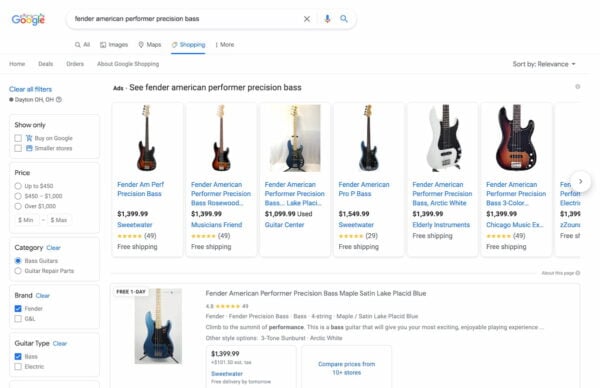Every online store needs marketing. You can do many things to get people interested in your products and get them to your shop. In this part of the Shopify SEO ultimate guide, we’d like to highlight some options quickly.
Paid ads and Google Shopping
Many Shopify stores get their first customers from paid ads. Paid ads are a great way of gaining visibility quickly. You get to carefully target who you want your ads to appear for based on terms and outcomes of your choosing. There’s no limit to what you can do with paid ads — the only limiting factor being what you want to pay for those ads, of course.
Then there’s Google Shopping, where you can get your products noticed as well. Getting listed there doesn’t even cost money if you’re in selected countries, that is. There’s a Google channel app that makes connecting your Shopify store to that boundless platform easy.

Read on: How to get your Shopify store on Google »
Social media marketing
Social media is vast — use it to your advantage! There are a ton of well-known platforms out there, like Instagram, Twitter, and Facebook, but also more niche ones, like Reddit. Get creative and find out where your audience lives. Find out what they need and connect! Build your brand, your voice, and push your store.
Video marketing
Buying something is a very delicate affair, and the more you can support your customer, the better. Video is an excellent way of getting your customers to learn more about your products. Video is booming, so don’t forget to invest in a proper video SEO strategy. We have a ton of great content if you want to learn how to do video SEO. And if you’re looking to add video content to your Shopify store, check out our quick guide.
Email marketing
A good email newsletter is essential for your store. It is one of the most successful ways of reaching people and keeping them connected to your store. You can use email marketing to keep customers up to date with the latest products and sales. In addition, you can also use it as part of your content marketing strategy — getting your content noticed by the right people.
Shopify comes with a dedicated email campaign app that lets you get started quickly. The first 2,500 emails per month are free of charge. Designing an email is picking a template and customizing it to your liking. You even get data to track the success of your newsletters.
Influencer marketing
Influencer marketing might be an option for you. In most niches, you’ll find influencers who’d like to talk about or promote your product. Influencer marketing is an exciting way of getting your name out there, and it might make sense for your industry.
Offline marketing
Don’t forget old-school offline marketing for your Shopify store. If you are a local store catering to a local audience, you have to think about offline marketing. Think of advertising in the local paper, printing some flyers, or doing a guerrilla sticker campaign. The options are endless.
Keep on reading: Get more sales on Shopify with these 14 tips »
Conversion rate optimization in Shopify
Your store should have great products, good content, an excellent design, and proper SEO to make the most of it. But even then, the chances are that you are still not getting the most out of your store. Getting customers is one thing — getting them to convert and come back again is a whole different thing.
Besides improving your store, you should also improve the experience a customer has in your store. You should try to take away any bump in the road that might keep a visitor from becoming a customer. These could be technical things — your shopping cart loads poorly. Or it might be related to your content — is the text on that CTA explicit enough? Can you find ways to improve your product pages?
This is the domain of conversion rate optimization. Start thinking about the user journey and see if you’ve missed a step in the process. Test different setups of your shopping cart to see which performs better. Put your product pages through the wringer. Track, test, change and improve!
Internationalization
Expanding your online store to markets outside your country has always been a chore. Things get complex fast, even with Shopify, getting everything set up — from international domains to hreflang, localization, and targeting. But there’s money to be made in the world, and why wouldn’t your shop have a piece of the pie?
To make selling a more viable option for online stores internationally, Shopify recently announced Markets. Shopify Markets takes the guesswork out of internationalization. It comes with automatic solutions for payments in local currencies, translation of content and interfaces, fulfillment and shipping, and even tax and custom handling.
For SEOs, the beautiful thing about Shopify Markets is the part of the international domain. Here, you can simply pick your proposed global domain setup, whether you use subfolders, subdomains, or top-level domains. A new Geolocator app helps redirect the customers to the proper domain in their respective countries. Shopify will automatically add the appropriate hreflang tags to the pages so search engines can also make sense of the setup.
How to move from WooCommerce to Shopify
One of the biggest competitors of Shopify is WooCommerce — we’ve compared them both in an article on this site. If you are looking to move from WooCommerce to Shopify, you can rest assured, as the process of migrating is pretty straightforward. First, you need to export your data from WooCommerce. Then, import your data into Shopify by way of the Store Importer app. Lastly, carefully check and review the imported data. Missing products or customers can be added manually. Check Shopify’s store migration guide for more information.


No comments:
Post a Comment